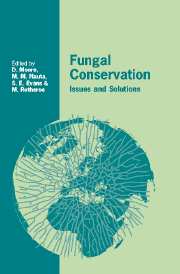Book contents
- Frontmatter
- Contents
- List of contributors
- Preface
- 1 Fungal conservation issues: recognising the problem, finding solutions
- 2 Current trends and perspectives for the global conservation of fungi
- 3 Conservation and management of forest fungi in the Pacific Northwestern United States: an integrated ecosystem approach
- 4 The future of fungi in Europe: threats, conservation and management
- 5 Fungi as indicators of primeval and old-growth forests deserving protection
- 6 Recognising and managing mycologically valuable sites in The Netherlands
- 7 Threats to hypogeous fungi
- 8 Wild mushrooms and rural economies
- 9 Threats to biodiversity caused by traditional mushroom cultivation technology in China
- 10 A preliminary survey of waxcap grassland indicator species in South Wales
- 11 Grasslands in the coastal dunes: the effect of nature management on the mycota
- 12 The conservation of fungi on reserves managed by the Royal Society for the Protection of Birds (RSPB)
- 13 Strategies for conservation of fungi in the Madonie Park, North Sicily
- 14 Fungal conservation in Ukraine
- 15 The threatened and near-threatened Aphyllophorales of Finland
- 16 Fungal conservation in Cuba
- 17 Microfungus diversity and the conservation agenda in Kenya
- 18 Fungi and the UK Biodiversity Action Plan: the process explained
- 19 The Scottish Wild Mushroom Forum
- 20 The contribution of national mycological societies: establishing a British Mycological Society policy
- 21 The contribution of national mycological societies: the Dutch Mycological Society and its Committee for Fungi and Nature Conservation
- 22 Fungal conservation in the 21st century: optimism and pessimism for the future
- Index
18 - Fungi and the UK Biodiversity Action Plan: the process explained
Published online by Cambridge University Press: 13 October 2009
- Frontmatter
- Contents
- List of contributors
- Preface
- 1 Fungal conservation issues: recognising the problem, finding solutions
- 2 Current trends and perspectives for the global conservation of fungi
- 3 Conservation and management of forest fungi in the Pacific Northwestern United States: an integrated ecosystem approach
- 4 The future of fungi in Europe: threats, conservation and management
- 5 Fungi as indicators of primeval and old-growth forests deserving protection
- 6 Recognising and managing mycologically valuable sites in The Netherlands
- 7 Threats to hypogeous fungi
- 8 Wild mushrooms and rural economies
- 9 Threats to biodiversity caused by traditional mushroom cultivation technology in China
- 10 A preliminary survey of waxcap grassland indicator species in South Wales
- 11 Grasslands in the coastal dunes: the effect of nature management on the mycota
- 12 The conservation of fungi on reserves managed by the Royal Society for the Protection of Birds (RSPB)
- 13 Strategies for conservation of fungi in the Madonie Park, North Sicily
- 14 Fungal conservation in Ukraine
- 15 The threatened and near-threatened Aphyllophorales of Finland
- 16 Fungal conservation in Cuba
- 17 Microfungus diversity and the conservation agenda in Kenya
- 18 Fungi and the UK Biodiversity Action Plan: the process explained
- 19 The Scottish Wild Mushroom Forum
- 20 The contribution of national mycological societies: establishing a British Mycological Society policy
- 21 The contribution of national mycological societies: the Dutch Mycological Society and its Committee for Fungi and Nature Conservation
- 22 Fungal conservation in the 21st century: optimism and pessimism for the future
- Index
Summary
Introduction
Lead partners, champions, priority species, SAPs, HAPs, and Country Groups are just some of a bewildering array of terms, jargon and acronyms that confront a novice to the UK Biodiversity Action Plan (BAP) (see Table 18.1). This chapter aims to give the background to the BAP, to explain in simple terms what is actually happening (focusing on the production of species and habitat action plans), and will consider the implications of this process for the conservation of fungi in the United Kingdom (UK).
Background
The United Nations Conference on the Environment and Development (the ‘Earth Summit’) in Rio de Janeiro, 1992, resulted in the widely publicised Convention on Biological Diversity, to which the UK is a signatory. One of the many requirements of the Convention was that individual states produce their own action plans or programmes for the conservation of biodiversity. Accordingly, in 1994, the UK Government published Biodiversity: the UK Action Plan (Anon., 1994). This document provided a summary of the state of UK biodiversity and the actions being taken to conserve it. Most importantly, it contained in a final section a set of ‘59 steps’ to be implemented by Government and its agencies. These 59 steps encompassed a range of activities, from the need to continue with the programme of site designations required by European Community Directives, to education and awareness programmes, to actions for UK overseas territories and for the limitation of UK fishing activities.
- Type
- Chapter
- Information
- Fungal ConservationIssues and Solutions, pp. 209 - 218Publisher: Cambridge University PressPrint publication year: 2001
- 4
- Cited by



